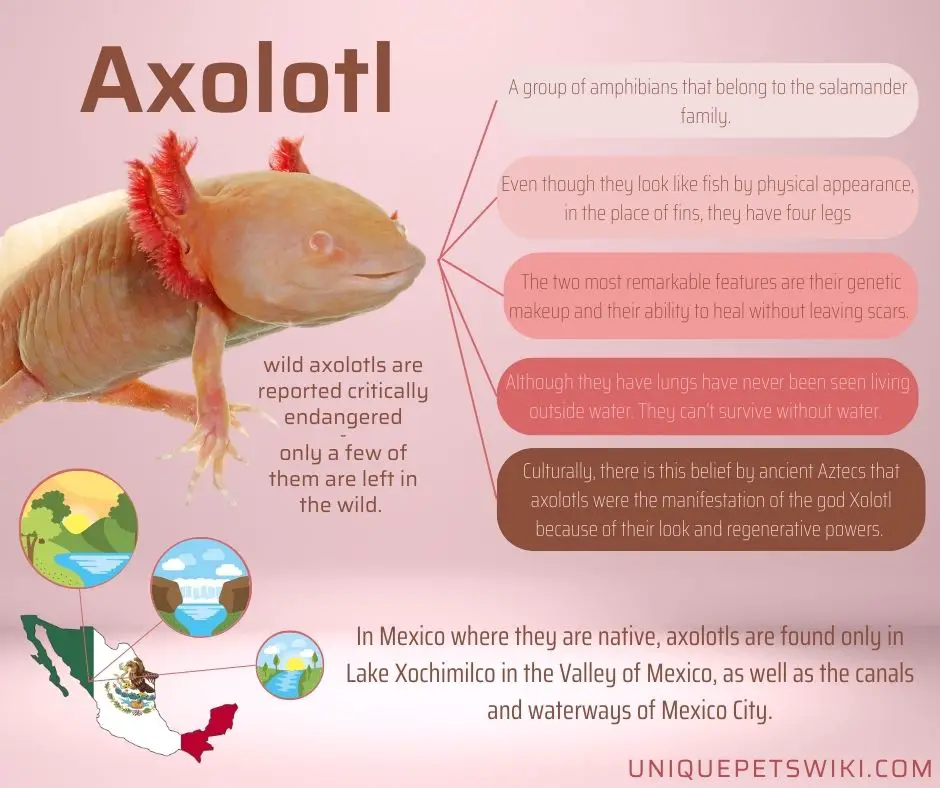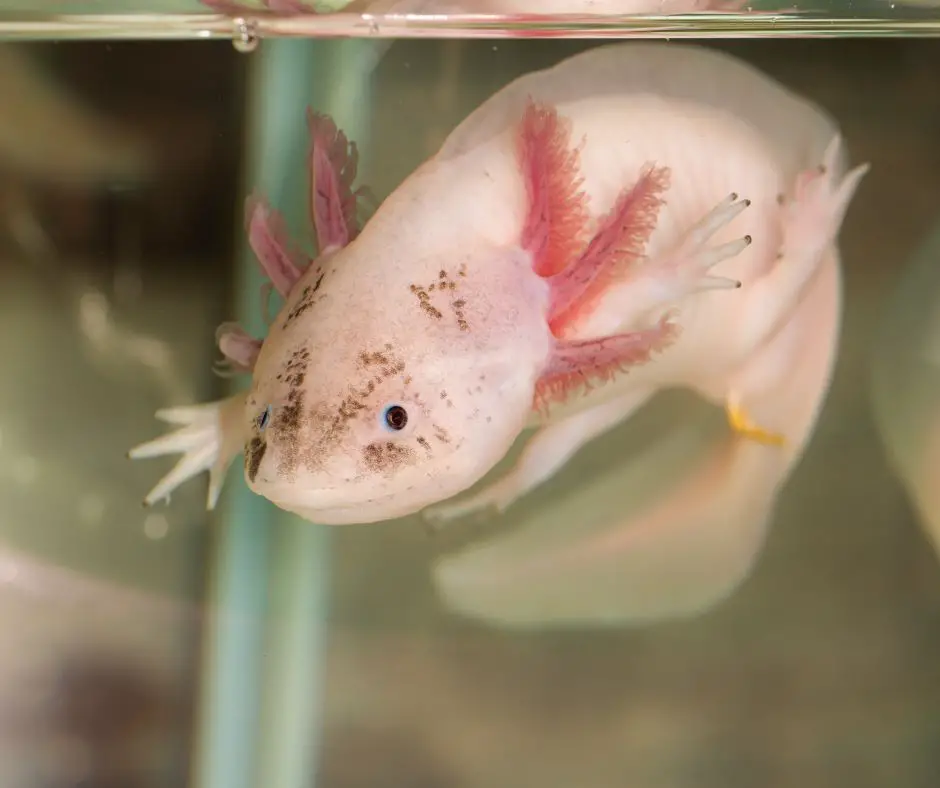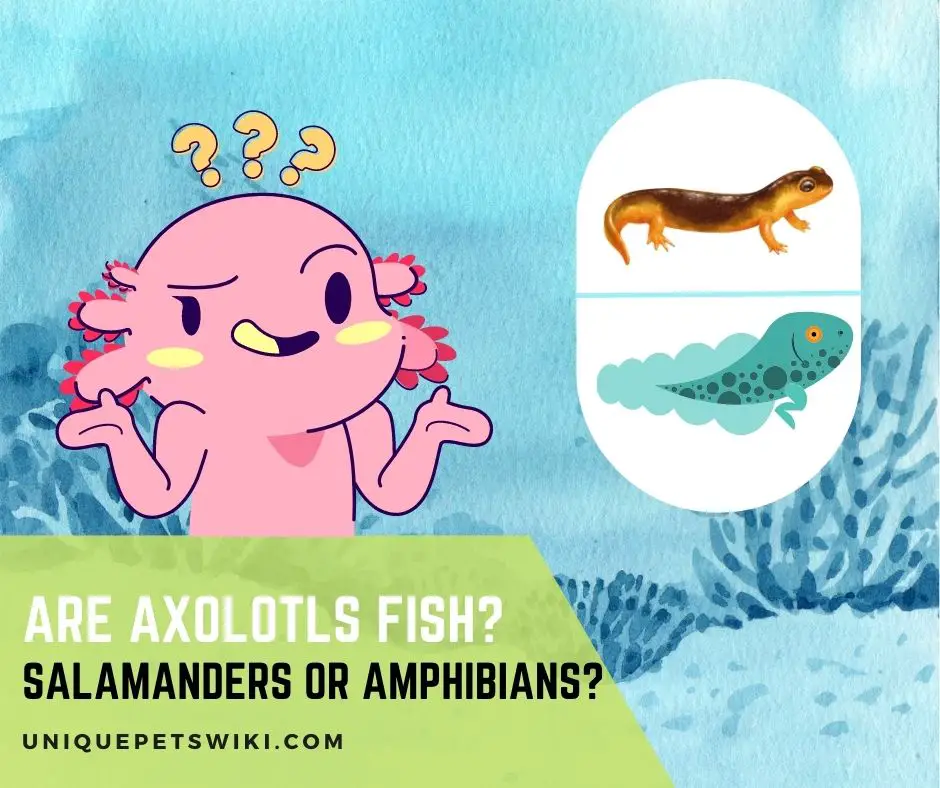There is a huge debate about what axolotls are and what they are not. This debate revolves around whether axolotls are amphibians, salamanders, or a species of fish. What do you think? Are axolotls fish?
Many people say that axolotls are fish because they look like one and live in the water like fish. Interestingly, axolotls aren’t a species of fish even though they look like one.
As with all amphibians, they live and breathe in the water. Although they have lungs that they can breathe with, they are hardly seen on land (that is living outside the water).
So this takes us to the fact that axolotls are salamanders. But what kind of animals are salamanders?
Salamanders are a group of amphibians that look like lizards with slender bodies, blunt snouts, short limbs projecting at right angles to the body, and a tail in both larvae and adults.
Want to learn more about axolotls, their classification, and care requirements? Read on to the end.
Contents
Are Axolotls Fish?
No, far from it; axolotls aren’t fish. They are a group of amphibians that belong to the salamander family.
Most people refer to them as fish because they have gills and look like fish. In Mexico, where axolotls originate, they are called the “Mexican walking fish.”
The reasons why they are called the “walking fish” aren’t far-fetched.
Firstly, axolotls are native to Lake Xochimilco in the Valley of Mexico and also the canals and waterways of Mexico City. Besides living in canals (water), they have gills with which they breathe like fish.
Secondly, even though they look like fish by physical appearance, in the place of fins, they have four legs which is something that is not a characteristic of fish.
These prompted the people in these regions to call them the Mexican walking fish.

What Makes Axolotls Special?
Belonging to the same anatomy and living in the same habitat as olms, frogs, newts, and fire salamanders, several features make axolotls different and special from other species of salamanders/amphibians.
The two most remarkable features are their genetic makeup and their ability to heal without leaving scars.
Axolotls are designed in such a way that they do not metamorphose as other amphibians do.
Note that animals that are amphibians have both gills and lungs, which means that they can live both in the water and on land.
While in the water, they will breathe with their gills and breathe with their lungs when on land.
However, axolotls, although they have lungs have never been seen living outside water. They can’t survive without water.
Also, unlike other species of amphibians and salamanders, axolotls can retain most of their larval features into adulthood—for example, their gills.
Axolotls are special from other species because they have a remarkable ability to regrow bodily organs and limbs that have been lost.
An Axolotl may regrow lost limbs, tail, central nervous system, and tissues of the eye and heart in just a few weeks.
If it has a head injury, it can regenerate its lungs, heart, spinal cord, and sections of its brain, and heals without leaving any scars. This is a remarkable feature that other species don’t have.
These distinct characteristics are accompanied by a genome that is remarkably complex, with 32 billion base pairs compared to around 3 billion base pairs in humans.
Their genome is the largest ever sequenced. This also explains why they are used in university labs for research studies.
Culturally, there is this belief by ancient Aztecs that axolotls were the manifestation of the god Xolotl because of their look and regenerative powers.
Because of this, axolotls were named after the Aztec god and were greatly treasured. They also believed that axolotls were a gift of food supplied to them by their god. So they use axolotls as food.
Where Do Axolotls Live?

In simple terms, axolotls live in water – this can be lakes, canals, or waterways.
In Mexico where they are native, axolotls are found only in Lake Xochimilco in the Valley of Mexico, as well as the canals and waterways of Mexico City.
Conservation and Why Are Axolotls Endangered?
According to the IUCN conservation index, wild axolotls are reported critically endangered – meaning that only a few of them are left in the wild.
But in captivity, they are kept in large numbers, both at homes and in the labs. Scientists fear that this species of amphibians will go extinct in the near future.
And this is because of the important biological value axolotls have in research and medicine.
Some of the reasons they are critically endangered include:
- Water pollution.
- Overfishing: the excessive use of axolotls as food amongst Mexicans has also contributed to the decline of this species in the wild.
- Habitat loss due to development: most of the natural habitats in Mexico city (the lakes) have been drained out to build infrastructures.
- Invasive species: being small in size, axolotls are at the top of the food chain. Hence, they are vulnerable to attack by other aquatic animals. The introduction of other species such as tilapia into their habitat has made axolotls decrease in their numbers.
So far, scientists have implemented a few ways axolotls can be preserved in the wild. These include:
- Advocate for axolotls by educating others on the importance of axolotl conservation.
- Discourage pet trade, which reduces the genetic diversity of axolotls.
- Donate to an axolotl conservation organization.
- Vote for politicians who place a high priority on wildlife protection.
- Participate in a conservation organization or a habitat rehabilitation facility.
- Changing our ways, particularly when it comes to eating axolotls.
- Use eco-friendly products that will not harm aquatic wildlife if channeled to the water.
Aqueon Aquarium Starter Kit with LED Lighting
- All the equipment needed to get started in one box
- Kit includes: glass aquarium, low profile LED hood, QuietFlow power filter, filter cartridge, submersible preset heater, premium fish food sample, water conditioner sample, fish net, thermometer and setup guide
- Preset heater will keep your aquarium temperature at a constant 78 degrees, appropriate for most tropical fish
- Low profile full hood contains vibrant cool white LED lighting to bring your aquatic environment to life
- Filter has a red LED light that flashes to indicate when it’s time to change the cartridge
Last update on 2022-12-30 / Affiliate links / Images from Amazon Product Advertising API
Similar Species to Axolotl
At some point you might be wondering – are there other species of animals (salamanders) that are similar to axolotls? Interestingly, axolotls are unique species of amphibians.
Although they belong to the salamander family, they are different in several ways from other species in the salamander group.
Physically, they have a unique appearance from others because of their many gills.
Other related species such as the Water Dogs and Mudpuppies only have three pairs of bushy gills at the rear of their flattened head.
Also, while most salamanders or amphibians undergo metamorphosis to transition between life in the water and life on land, axolotls do not undergo such metamorphosis.
Therefore, the only three species that could be similar to axolotls are their closest relative, the tiger salamander Ambystoma tigrinum whose larvae are called water dogs, mudpuppies, and the more distant relative, the spotted salamander Ambystoma maculatum.
Note that Water Dogs and Mudpuppies are not entirely the same as axolotls.
They only belong to the same group/family and share two or more other features. Read about these animals to learn more about how they are different.
Also read: Water Dog Vs Axolotl
Aquarium Siphon Vacuum Cleaner
- 【3 in 1 Function】: ① Dirt Suction. Gravel Vacuum for Aquarium equipped with a duckbill suction inlet accessory, and it is easy to suck the feces away. ② Sand Washing. Aquarium siphon with 3D Filter Basket Net, protect your love fish and small gravel from suck out of the aquarium. ③ Water Changing. Built-in dual airbags, atmospheric cavity, good resilience, effortless operation.
- 【Working Principle】: hygger's unique patented design --- equipped with a handle type manual press, which has more operating space and saves labor and brings convenience, by testing the fastest speed is to press 7 times. Sand Washer has 2 thickened airbags inside, which can pump water quickly. And using PP ABS materials, resistance to extrusion, do not worry about airbag damage and leakage, can be used for a long time.
- 【Easy to Use】: Push the siphon switch of the aquarium siphon vacuum cleaner several times, and make sure that the inlet tube part is full of water, and then observe the outlet hose. After the water continuously flows out, you can stop push and observe whether it will automatically. If not, continue to operate until the water will flow out quickly and automatically. The sand can move up and down in the extension tube to remove debris from your aquarium.
- 【Accessories Include】:1 *Air-pressing control body; 2 *Extension Inlet Tube; 1 *Extension tube connector; 1 *User Manual; 1 *Duckbill suction inlet(Debris vacuum); 1 *Outlet hose(79inch PVC Hose),the water pipe can be cut according to demand; 1 *Water Flow Clamp(Flow Control),easily adjust water flow; 1 *Fixture clamp(Water pipe clamp), freely fix, free your hands.
- 【Wide Application】: Aquarium Vacuum Gravel Cleaner is suitable for various types of fish tanks, with spliced extension tubes, two-stage splicing combination, both large and small tanks are suitable, and extension tube can be installed according to demand.Four basic combinations(excluding handle length):2 tubes(31.4inch);2 tubes + head(34inch);1 tube(16inch);1 tube + head accessories(18inch).
Last update on 2022-12-29 / Affiliate links / Images from Amazon Product Advertising API
In Conclusion
The axolotl is a special species of salamander, specifically a neotenic salamander.
Meaning that it retains most of its larval features as it grows to adulthood. It is also known by its scientific name, Ambystoma mexicanum.
The axolotls are so distinctive in their appearance and behavior which is why many pet enthusiasts are willing to pay any amount to have them as pets.
They are unique in that they have the ability to regenerate limbs and organs, like a lizard.
They can also regenerate their tail when it is lost, making them different from other salamanders that cannot regenerate their tails.
They are also known for their large external gills. Because f all these unique characteristics, axolotls are used in scientific research.
The fact that they are used as food amongst Mexicans explains why they are greatly endangered in the wild.


